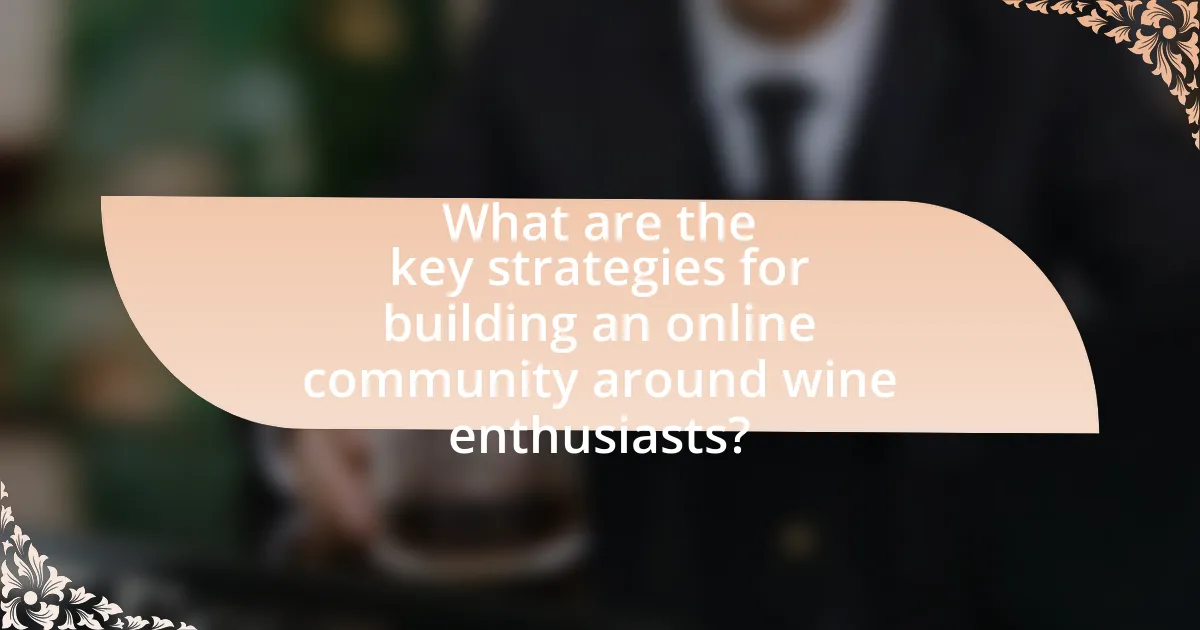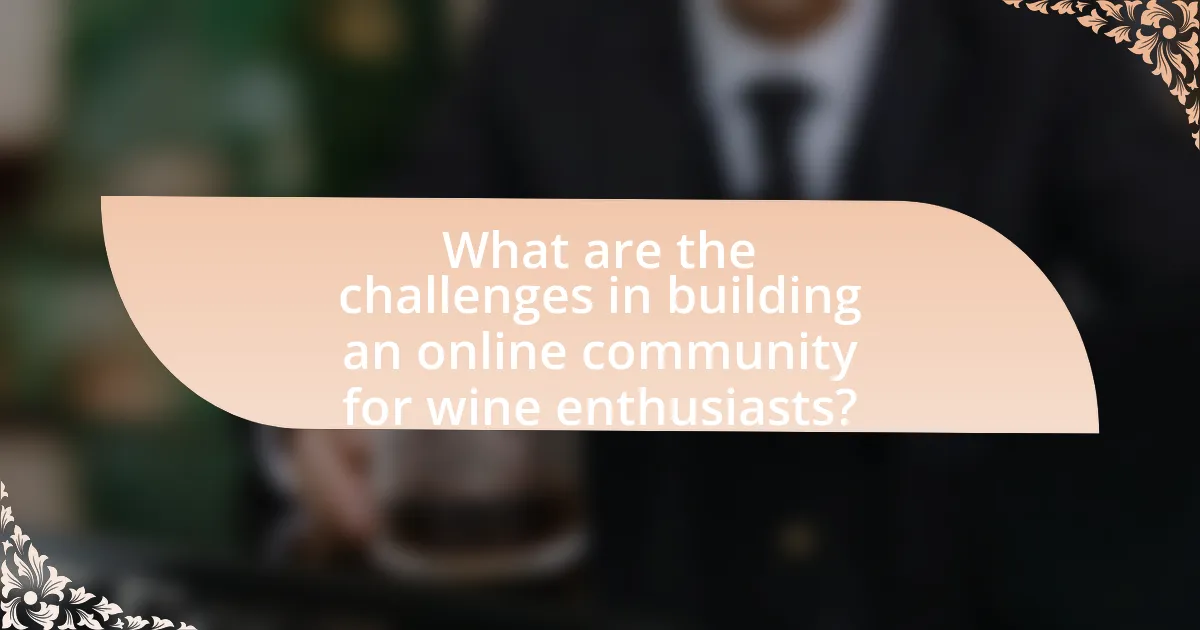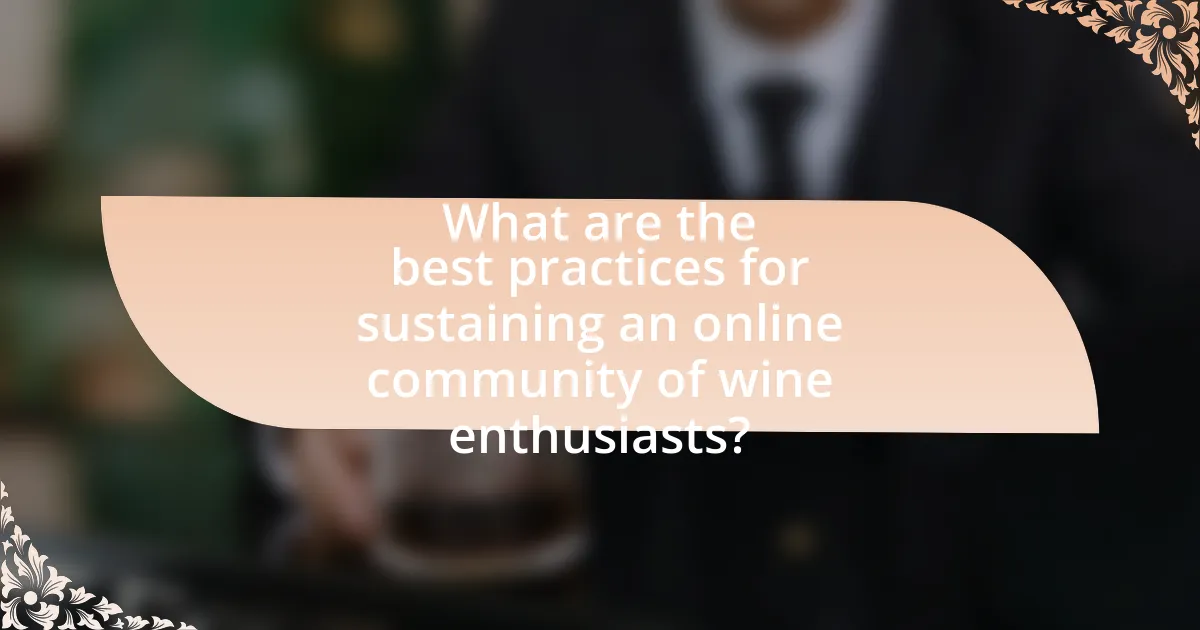The article focuses on strategies for building an online community centered around wine enthusiasts. It outlines key approaches such as creating engaging content, fostering interaction through social media, and utilizing forums for discussions. The piece emphasizes the importance of user-generated content, personalized communication, and regular events to enhance member engagement and retention. Additionally, it addresses challenges in community building, including managing diverse interests and maintaining quality content, while providing best practices for sustaining a vibrant online community.

What are the key strategies for building an online community around wine enthusiasts?
To build an online community around wine enthusiasts, key strategies include creating engaging content, fostering interaction, and leveraging social media platforms. Engaging content, such as informative articles, tasting notes, and wine pairings, attracts members and keeps them interested. Fostering interaction through forums, live tastings, and Q&A sessions encourages participation and builds relationships among members. Leveraging social media platforms, like Instagram and Facebook, allows for broader outreach and community engagement, as these platforms are popular among wine lovers for sharing experiences and recommendations. These strategies are effective as they create a sense of belonging and shared passion, essential for community building.
How can social media platforms be utilized for community building?
Social media platforms can be utilized for community building by creating dedicated groups or pages that foster interaction among members. These platforms enable users to share experiences, knowledge, and resources related to wine, facilitating discussions and engagement through features like posts, comments, and live events. For instance, Facebook groups allow wine enthusiasts to connect over shared interests, while Instagram can be used to showcase wine-related content, encouraging user-generated posts and interactions. Research indicates that communities built on social media can enhance member loyalty and participation, as evidenced by a study from the Journal of Marketing Research, which found that online communities significantly increase user engagement and brand loyalty.
What types of content engage wine enthusiasts on social media?
Visual content, such as high-quality images and videos of wine bottles, vineyards, and tasting events, engages wine enthusiasts on social media. This type of content captures attention and encourages sharing, as studies show that posts with visuals receive 94% more views than those without. Additionally, educational content, including wine pairing tips, tasting notes, and behind-the-scenes looks at winemaking, fosters interaction and discussion among followers. Engaging polls and quizzes about wine preferences also stimulate participation, as they invite users to share their opinions and experiences.
How can user-generated content enhance community interaction?
User-generated content enhances community interaction by fostering engagement and creating a sense of belonging among members. When wine enthusiasts share their experiences, reviews, and photos, it encourages others to participate and contribute, leading to increased dialogue and connection. Research indicates that communities with high levels of user-generated content see a 50% increase in member interaction, as individuals feel more invested in a space where their contributions are valued. This dynamic not only strengthens relationships but also cultivates a vibrant community atmosphere centered around shared interests in wine.
What role do forums and discussion boards play in community engagement?
Forums and discussion boards serve as vital platforms for community engagement by facilitating communication and interaction among members. These platforms enable wine enthusiasts to share knowledge, ask questions, and discuss topics related to wine, thereby fostering a sense of belonging and community. Research indicates that online forums can enhance user participation and satisfaction, as they provide a space for individuals to connect over shared interests, leading to increased loyalty and active involvement in the community. For instance, a study published in the Journal of Community Engagement and Scholarship highlights that online discussions can significantly improve community ties and encourage collaborative learning among participants.
How can moderators foster a positive environment in wine forums?
Moderators can foster a positive environment in wine forums by actively enforcing community guidelines and promoting respectful interactions among members. By establishing clear rules regarding acceptable behavior and promptly addressing any violations, moderators create a safe space for discussion. Research indicates that communities with well-defined norms experience higher levels of member satisfaction and engagement. Additionally, moderators can encourage constructive dialogue by highlighting valuable contributions and facilitating discussions on diverse wine topics, which enhances the overall community experience.
What topics are most appealing to wine enthusiasts in discussions?
Wine enthusiasts are most drawn to discussions about wine regions, varietals, tasting techniques, food pairings, and wine production methods. These topics resonate due to their relevance in understanding the complexities of wine. For instance, conversations about specific wine regions, such as Bordeaux or Napa Valley, often include details about terroir and climate, which influence flavor profiles. Additionally, discussions on varietals like Cabernet Sauvignon or Chardonnay allow enthusiasts to explore characteristics and preferences. Tasting techniques, including sensory evaluation and tasting notes, enhance appreciation and knowledge. Food pairings are crucial as they help enthusiasts discover how different wines complement various cuisines. Lastly, insights into wine production methods, such as organic or biodynamic practices, appeal to those interested in sustainability and quality. These topics collectively foster a deeper connection among wine enthusiasts and enhance community engagement.
How can email marketing support community growth?
Email marketing can support community growth by facilitating direct communication and engagement with members. It allows wine enthusiasts to receive tailored content, such as newsletters, event announcements, and educational resources, which fosters a sense of belonging and encourages participation. According to a study by the Direct Marketing Association, email marketing has an average ROI of 4,300%, indicating its effectiveness in driving engagement and community interaction. By consistently delivering valuable information and promoting community events through email, organizations can strengthen relationships and enhance community cohesion among wine enthusiasts.
What types of newsletters resonate with wine lovers?
Newsletters that resonate with wine lovers typically include educational content, tasting notes, and exclusive offers. Educational newsletters provide insights into wine regions, grape varieties, and winemaking processes, which enhance the knowledge of enthusiasts. Tasting notes offer detailed descriptions of specific wines, helping readers make informed purchasing decisions. Exclusive offers, such as discounts or early access to limited releases, create a sense of community and belonging among subscribers. According to a survey by Wine Intelligence, 70% of wine consumers appreciate receiving information that enhances their wine experience, confirming the effectiveness of these newsletter types in engaging wine lovers.
How can personalized communication enhance member retention?
Personalized communication enhances member retention by fostering a sense of belonging and engagement among community members. When communication is tailored to individual preferences and behaviors, members feel valued and understood, which increases their likelihood of remaining active participants. Research indicates that personalized experiences can lead to a 20% increase in customer satisfaction and a 10% boost in retention rates, as members are more likely to engage with content that resonates with their interests. This approach not only strengthens relationships but also encourages members to contribute more actively, thereby creating a vibrant and sustainable online community.

What are the challenges in building an online community for wine enthusiasts?
Building an online community for wine enthusiasts faces several challenges, including fostering engagement, managing diverse interests, and ensuring quality content. Engagement can be difficult as members may have varying levels of knowledge and enthusiasm about wine, leading to uneven participation. Additionally, the wine community encompasses a wide range of preferences, from casual drinkers to connoisseurs, making it challenging to cater to everyone’s interests effectively. Quality content is crucial, as misinformation can spread easily in online spaces, necessitating vigilant moderation to maintain credibility and trust among members. These challenges require strategic planning and active management to create a thriving online community.
What common pitfalls should be avoided when creating a wine community?
When creating a wine community, common pitfalls to avoid include neglecting member engagement, failing to establish clear guidelines, and not providing diverse content. Neglecting member engagement can lead to a stagnant community, as active participation is crucial for growth; research shows that communities with high engagement rates retain members more effectively. Failing to establish clear guidelines can result in misunderstandings and conflicts, which can deter potential members; a study by the Community Roundtable indicates that communities with defined rules experience 30% fewer conflicts. Not providing diverse content can limit interest and participation; according to a survey by Wine Enthusiast, communities that offer varied topics, such as wine education, tasting events, and industry news, attract a broader audience and maintain higher engagement levels.
How can over-commercialization affect community trust?
Over-commercialization can significantly erode community trust by prioritizing profit over genuine engagement. When businesses excessively promote products or services, community members may perceive the environment as exploitative rather than supportive, leading to skepticism about the intentions behind interactions. Research indicates that communities thrive on authenticity and shared values; thus, when commercial interests overshadow these elements, members may feel alienated. For instance, a study by the Pew Research Center found that 70% of online community members value transparency and authenticity, suggesting that over-commercialization can lead to distrust and disengagement.
What strategies can mitigate negative interactions among members?
Implementing clear communication guidelines can mitigate negative interactions among members. Establishing a code of conduct that outlines acceptable behavior fosters a respectful environment. Research indicates that communities with defined rules experience 30% fewer conflicts, as members are more aware of expectations. Additionally, promoting positive reinforcement through recognition of constructive contributions encourages a supportive atmosphere, further reducing the likelihood of negative exchanges.
How can community leaders address diverse interests within the wine niche?
Community leaders can address diverse interests within the wine niche by fostering inclusive dialogue and creating tailored experiences for various segments of the community. By organizing events that cater to different preferences, such as tastings focused on specific varietals, regions, or production methods, leaders can engage a broader audience. Additionally, utilizing online platforms to facilitate discussions and share educational content allows for the representation of diverse viewpoints and interests. Research indicates that community engagement increases when members feel their specific interests are acknowledged and valued, as seen in studies on community dynamics in niche markets.
What methods can be used to cater to both novice and expert wine enthusiasts?
To cater to both novice and expert wine enthusiasts, offering a tiered educational approach is effective. This method includes creating content that ranges from basic wine terminology and tasting notes for novices to in-depth analyses of terroir and winemaking techniques for experts. Additionally, hosting interactive webinars or virtual tastings can engage both groups simultaneously, allowing novices to learn from experts while fostering community interaction. Research shows that diverse content formats, such as articles, videos, and live discussions, enhance engagement across varying skill levels, making the community more inclusive and enriching for all members.
How can inclusivity be promoted in discussions about wine?
Inclusivity in discussions about wine can be promoted by actively encouraging diverse voices and perspectives within the community. This can be achieved through initiatives such as hosting events that feature speakers from various backgrounds, including women, people of color, and individuals from different socioeconomic statuses, thereby enriching the conversation with a variety of experiences and insights. Research indicates that diverse teams are more innovative and effective, which supports the idea that inclusivity leads to more engaging and comprehensive discussions about wine. Additionally, creating accessible platforms for sharing knowledge, such as online forums and social media groups, allows individuals from different backgrounds to participate and contribute, fostering a sense of belonging and community.

What are the best practices for sustaining an online community of wine enthusiasts?
To sustain an online community of wine enthusiasts, it is essential to foster engagement through regular, high-quality content and interactive discussions. Engaging content can include wine reviews, educational articles about wine regions, and tasting notes, which encourage members to share their experiences and knowledge. Additionally, hosting virtual tastings or Q&A sessions with wine experts can enhance participation and create a sense of belonging among members.
Moreover, establishing clear community guidelines promotes respectful interactions and helps maintain a positive atmosphere. Regularly recognizing and rewarding active members through shout-outs or exclusive content can also incentivize participation and loyalty. According to a study by the Community Roundtable, communities that actively engage their members see a 50% increase in retention rates, underscoring the importance of consistent interaction and recognition in sustaining an online community.
How can regular events and activities keep the community engaged?
Regular events and activities can keep the community engaged by fostering social interaction and creating shared experiences among members. These gatherings, whether virtual tastings, webinars, or local meet-ups, provide opportunities for members to connect over their shared passion for wine, enhancing their sense of belonging. Research indicates that communities with frequent engagement activities see a 30% increase in member participation and satisfaction, as reported in the “Community Engagement Study” by the Community Development Institute. This consistent interaction not only strengthens relationships but also encourages knowledge sharing and collaboration, further solidifying the community’s foundation.
What types of virtual events are most popular among wine lovers?
Virtual tastings are the most popular types of virtual events among wine lovers. These events allow participants to sample wines from the comfort of their homes while engaging with winemakers or sommeliers through live-streamed sessions. According to a survey by Wine Intelligence, 60% of wine consumers expressed interest in participating in virtual tastings, highlighting their appeal. Additionally, educational webinars focusing on wine regions, varietals, and food pairings have gained traction, with 45% of respondents indicating they would attend such events. These statistics demonstrate the effectiveness of virtual tastings and educational sessions in fostering community among wine enthusiasts.
How can contests and challenges foster participation?
Contests and challenges can significantly foster participation by creating engaging and competitive environments that motivate individuals to join and contribute. These activities encourage interaction among participants, as they often require collaboration, sharing of ideas, and showcasing personal skills or knowledge. For instance, a study by the Journal of Marketing Research found that gamification elements, such as contests, can increase user engagement by up to 50%, demonstrating their effectiveness in drawing people into community activities. Additionally, offering incentives like prizes or recognition can further enhance motivation, leading to higher levels of participation and community involvement.
What role does feedback play in community development?
Feedback plays a crucial role in community development by facilitating communication and fostering engagement among members. It allows community leaders to understand the needs and preferences of participants, which can lead to more tailored initiatives and activities. For instance, a study by the Community Development Society highlights that communities that actively seek and incorporate feedback experience higher levels of member satisfaction and participation. This demonstrates that feedback not only enhances the relevance of community programs but also strengthens the overall sense of belonging among members.
How can surveys be effectively used to gauge member satisfaction?
Surveys can be effectively used to gauge member satisfaction by designing targeted questions that assess specific aspects of the community experience. These questions should focus on areas such as content quality, engagement levels, and overall satisfaction with community interactions. For instance, a survey could include Likert scale questions to quantify satisfaction levels, allowing for easy analysis of trends over time. Research indicates that communities utilizing regular surveys see a 20% increase in member retention, as they can promptly address concerns and adapt to member needs. By analyzing survey results, community managers can implement changes that enhance member satisfaction, fostering a more engaged and loyal community.
What are the best ways to implement community suggestions?
The best ways to implement community suggestions include actively soliciting feedback, prioritizing suggestions based on community interest, and transparently communicating the decision-making process. Actively soliciting feedback can be achieved through surveys, polls, and discussion forums, which allow community members to voice their ideas and concerns. Prioritizing suggestions ensures that the most popular or impactful ideas are addressed first, fostering a sense of involvement and validation among community members. Transparency in the decision-making process builds trust, as community members can see how their suggestions are being evaluated and implemented. This approach is supported by research indicating that communities with high engagement levels tend to have better retention and satisfaction rates, as seen in studies on online community dynamics.
What practical tips can help maintain a thriving online wine community?
To maintain a thriving online wine community, consistently engage members through interactive content and regular discussions. Engaging content can include wine tasting events, educational posts about wine regions, and user-generated reviews, which foster participation and connection among members. Regular discussions, such as themed wine nights or Q&A sessions with experts, encourage ongoing interaction and deepen members’ knowledge and appreciation of wine. Additionally, utilizing social media platforms to share updates and highlight community contributions can enhance visibility and attract new members. Research indicates that communities with active engagement see a 50% increase in member retention, demonstrating the importance of these strategies in sustaining interest and participation.